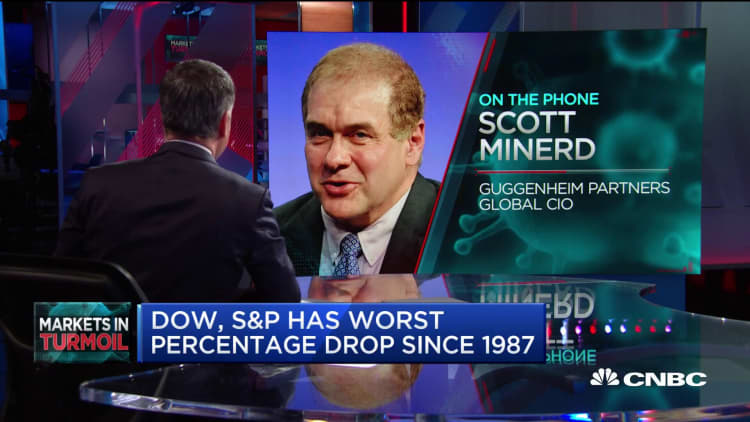
With stocks nose-diving again, Wall Street strategists are mostly punching in the dark because of the uncertainty surrounding the coronavirus outbreak and economic impact.
But they are giving clients some idea of what needs to happen for stocks to eventually bottom here.
Stocks plunged Monday even after the Federal Reserve's emergency move to ease lending aggressively. Many said the central bank's surprise action actually added to investor panic and stocks would only bottom when more fiscal stimulus is rolled out and the coronavirus outbreak stops worsening.
Mislav Matejka, head of global equity strategy at JPMorgan, gave three things that need to happen for a rebound to occur: "1. We get a much more aggressive fiscal policy response, 2. If the original problem, virus outbreak, starts showing clear signs of seasonality/peaking out, or 3. If markets overshoot in pricing in of a recession, something which we think we are still some way away from, in contrast to the prevailing consensus wisdom, which argues that recession is already fully in the price."
Investors have been dumping stocks at a rapid pace amid growing anxiety over the coronavirus. Monday's trading is slated to erase stocks' massive gains on Friday after President Donald Trump declared a national emergency to help combat the virus. The S&P 500 popped more than 9% on Friday, its biggest gain since 2008.
Monday's sell-off followed the Fed's shocking move on Sunday to cut rates by 125 basis points to a target range of 0% to 0.25% and launch a massive $700 billion quantitative easing program to offset the negative impact from the coronavirus.
A peak in infection rate
Similar to JPMorgan, Credit Suisse also believes the market will only bottom after a peak in the daily infection rate of the coronavirus.
Andrew Garthwaite, global equity strategist at Credit Suisse, noted that in the SARS crisis in 2003, the market troughed a week after infection cases topped.
The coronavirus has infected more than 160,000 people globally and killed more than 6,500, according to figures from Johns Hopkins University. In the U.S., there have been at least 3,774 confirmed cases and 69 deaths, according to Johns Hopkins totals. But the numbers are likely higher because of the lack of testing.
Officials from city, state and national governments have all stepped in, encouraging "social distancing" in order to curb the fast-spreading virus.
Clear-cut fiscal stimulus
Wall Street is also calling for more stimulus on the fiscal front before stocks can stop falling. Many believe the action so far from the Trump administration is far from enough.
Trump freed up roughly $50 billion when declaring a national emergency last week, but the amount of money is relative small for a $22 trillion economy, Tobias Levkovich, Citi's chief U.S. equity strategist, said in a note. He also said the payroll tax cuts Trump floated won't aid those no longer on the payroll, who could be the most in need.
"Most economists agree that now is not the time to quibble over how big the deficit gets, but different ideologies and plans will have to converge so as to find a program that is significant enough and quickly made available," Levkovich said.
The strategist said the timing could be difficult considering how challenging it was to roll out the Troubled Asset Relief Program to battle the financial crisis in 2008. The program, also know as TARP, cleared out some of the damage done to bank balance sheets while also providing funding mechanisms for small businesses and other parts of the economy.
"More equity market damage was necessary to build a consensus," Levkovich said. "Investors will have to be more patient since there are no easy solutions from our perspective. Indeed, we perceived last Friday's bounce as unwarranted and hence the S&P 500 is likely to still suffer near term dips and continued volatility."
— CNBC's Michael Bloom contributed reporting
Subscribe to CNBC PRO for exclusive insights and analysis, and live business day programming from around the world.


